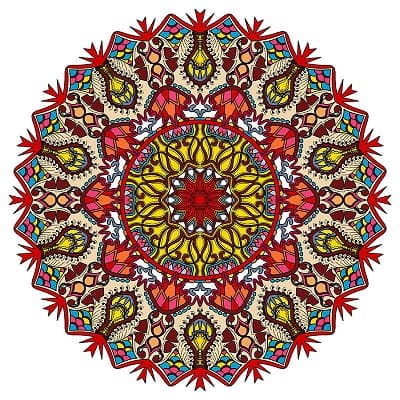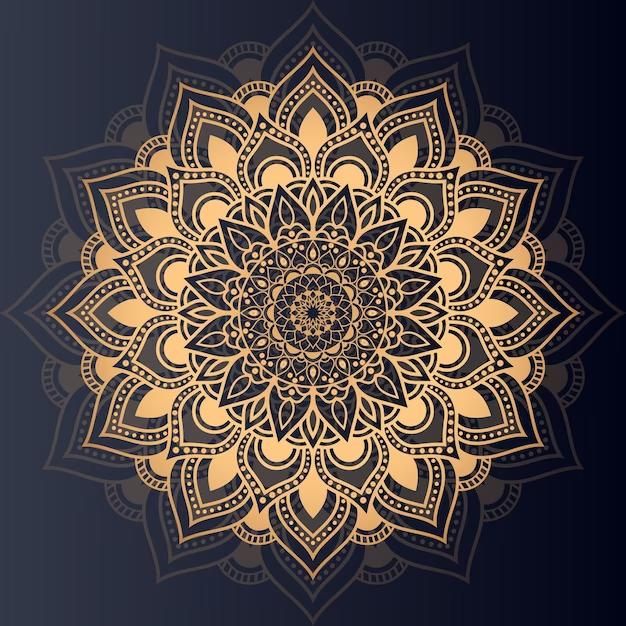Mandalas are intricate geometric patterns that hold deep significance across various cultures and spiritual practices. Their beauty lies not only in their visual appeal but also in their profound meanings and uses. In this article, we will explore the significance of mandalas, their historical background, and their applications in meditation and art therapy.
What is a Mandala?

The word “mandala” comes from the ancient Indian language of Sanskrit, meaning “circle.” Traditionally, mandalas are circular designs that represent the universe, wholeness, and unity. They can be found in Hindu and Buddhist traditions, often serving as spiritual symbols used for meditation and reflection. The circular form signifies the idea of completeness and infinity, embodying the connection between the inner self and the outer universe.
Historical Background

Mandalas have been present in various cultures throughout history. In Hinduism, they are often used in rituals and ceremonies, representing the cosmos and the journey toward enlightenment. In Buddhism, mandalas serve as a tool for meditation, guiding practitioners on their spiritual journey. Tibetan Buddhism features intricate mandalas that are often created from colored sand, emphasizing the transient nature of life.
Symbolism of Mandalas
The various elements within a mandala carry significant symbolism. Here are some key components:
The Circle: Represents wholeness and unity, illustrating the interconnectedness of all things. It signifies the cyclical nature of life, death, and rebirth.
The Center: Often referred to as the “bindu,” the center of a mandala symbolizes the starting point of creation. It represents focus and the essence of existence, urging individuals to find their core.
Geometric Patterns: The shapes and patterns found within a mandala convey specific meanings. Triangles may symbolize the element of fire, while squares often represent earth. Each design element contributes to the overall message of the mandala.
Colors: The colors used in mandalas also hold significance. For instance, blue may represent tranquility, while red signifies passion. The choice of colors can evoke different emotions and states of mind.
Mandalas in Meditation
Mandalas play a crucial role in meditation practices. Their intricate designs can help calm the mind, allowing individuals to focus on their breath and inner thoughts. When meditating with a mandala, practitioners often visualize themselves at the center, gradually expanding their awareness outward.
This practice fosters mindfulness, encouraging a deeper connection with oneself and the universe. By concentrating on the mandala, individuals can explore their feelings, reduce stress, and enhance their overall well-being.
Mandalas in Art Therapy
In recent years, mandalas have gained popularity in art therapy. Creating mandalas can be a therapeutic tool for self-expression and emotional healing. The process of drawing or coloring mandalas allows individuals to channel their thoughts and feelings, providing a sense of relaxation and focus.
Art therapists often use mandalas to help clients explore their emotions and navigate personal challenges. The act of creating a mandala can lead to increased self-awareness and a greater understanding of one’s inner world.
How to Create Your Own Mandala
Creating a mandala is a simple yet fulfilling process. Here’s how you can start:
Gather Your Materials: All you need is paper and some coloring tools, such as colored pencils, markers, or paints.
Choose a Center Point: Begin by marking a center point on your paper. This will be the heart of your mandala.
Draw the Outline: Using a compass or a round object, draw a large circle around the center. You can create smaller circles within the larger one, depending on your design.
Add Patterns: Begin to fill in the circles with geometric shapes, lines, and symbols that resonate with you. Don’t be afraid to experiment with different designs.
Incorporate Color: Choose colors that reflect your emotions or intentions. Fill in your mandala, allowing your creativity to flow.
Reflect: Once you’ve completed your mandala, take a moment to reflect on the process and what it represents to you.
The meaning of mandala extends far beyond its aesthetic appeal. With roots in spirituality and deep symbolism, mandalas serve as powerful tools for meditation, self-discovery, and healing. Whether you are drawn to create your own mandala or simply appreciate their beauty, understanding their significance can enrich your spiritual journey and enhance your mindfulness practice. Embrace the circle of life, and let the mandala guide you toward wholeness and peace. If you are a follower of Mandala, you can buy Mandala Merch and Gift at Mandala Tapestry.
